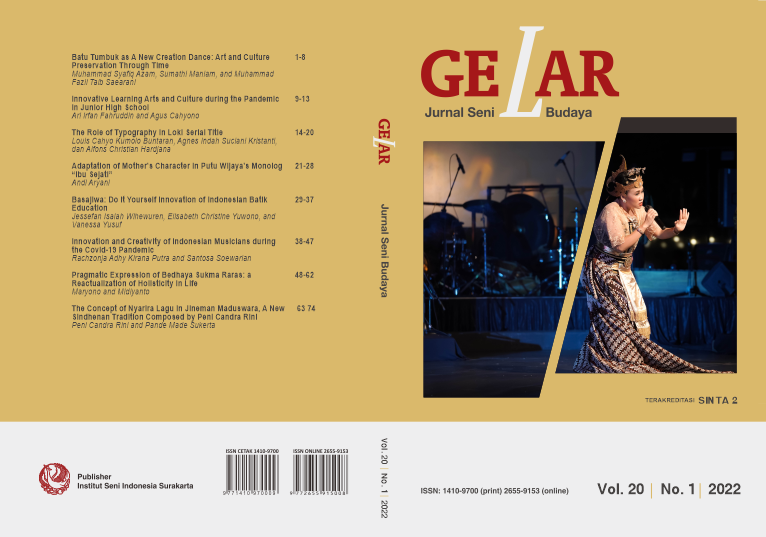Batu Tumbuk as A New Creation Dance: Art and Culture Preservation Through Time
Main Article Content
Abstract
This research aims to analyze the choreography of the New Creation dance, Batu Tumbuk by Muhaldin Jamin, which was staged in 2015. The term ‘New Creation dance’ refers to the dance that undergoes a process of improvement or refinement that is appropriate to the passage of time but does not affect the traditional values of the community. Hence, this research discusses the Batu Tumbuk dance from the aspect of choreography. The choreographic approach by Minton (1997) is used in this article to discuss the choreographic aspects of the New Creation dance selected. The methodology used for this research was qualitative. Data collection was conducted by using observational methods, unstructured interviews, and library methods. The findings of this research show that the choreography of Batu Tumbuk dance has undergone the creative process of movements and development in terms of composition in the performances presented. Based on the various elements of Malay traditional dance, it is shown that the development processes of Batu Tumbuk dance include actions such as casting, floor patterns and additional props as forms of dance creations. The implications of this research could benefit local choreographers in providing the reference for understanding the terms and concepts of the New Creation dance choreography that continues the original tradition, as a source to be processed and developed in accordance with the passage of time aimed to preserve cultural art heritage.
Downloads
Article Details
Copyright
Authors who publish with Gelar: Jurnal Seni Budaya agrees to the following terms:
- Authors retain copyright and grant the journal right of first publication with the work simultaneously licensed under a Creative Commons Attribution License (CC BY-SA 4.0) that allows others to share the work with an acknowledgment of the work's authorship and initial publication in this journal.
- Authors are able to enter into separate, additional contractual arrangements for the non-exclusive distribution of the journal's published version of the work (e.g., post it to an institutional repository or publish it in a book), with an acknowledgment of its initial publication in this journal.
- Authors are permitted and encouraged to post their work online (e.g., in institutional repositories or on their website) prior to and during the submission process, as it can lead to productive exchanges, as well as earlier and greater citation of published work.
References
Alvian, R. (2017). Pengaruh Kegiatan Seni Tari Kreasi Terhadap Kepercayaan Diri Anak Usia 5-6 Tahun Di KB-TK Hj. Isriati Baiturrahman 2 Semarang. Indonesia: Universitas Negeri Semarang.
Aprilina, N. G. (2019). Pengaruh Tari Kreasi Terhadap Perkembangan Motorik Kasar Anak Usia 5-6 Tahun Di Ra Perwanida II Bandar Lampung. Indonesia: Universitas Islam Negeri Raden Intang Lampung.
Bruce L. Berg, H. L. (2011). Qualitative Research Methods for the Social Sciences. USA: Karen Hanson.
Forsythe, W. (2011). William Forsythe and the Practice of Choreography. USA and Canada: Routledge.
Kaeppler, A. L. (1972). Method and Theory in Analyzing Dance Structure with an Analysis of Tongan Dance. Ethnomusicology, Vol. 16, No 2, 173.
Kaeppler, A. L. (1978). Dance in Antropological Perspective. Annual Review of Anthropology, 7, 32 & 34.
Othman Lebar. (2006). Penyelidikan Kualitatuf: Pengenalan kepada Teori dan Metod. Tanjong Malim: Universiti Pendidikan Sultan Idris.
Minton, S. C. (1997). Choreography: A Basic Approach Using Improvisation Second Edition. USA: Human Kinetics.
Mohd Anid Md Nor. (2001). Blurring Images, Glowing Likeness: Old and New Styles in Traditional Dances of Malaysia. Yearbook for Traditional Music, 33, 65-66.
Sem Cornelyoes Bangun, S. T. (2017). Buku Guru Seni Budaya . Indonesia: Buku Sekolah Elektronik (BSE).
Smith-Autard, J. M. (2004). Dance Composition Fifth Edition. USA: Routledge.
Youngerman, S. (1975). Method and Theory in Dance Research: An Anthropological Approach. Yearbook of the International Fol Music Council, 7, 125-126.
Muhaldin Jamin. (2020, Oktober 10). Tarian Batu Tumbuk [Interview]
Shahril Akla. (2020, November 12). Tari Kreasi Baharu [Interview]
